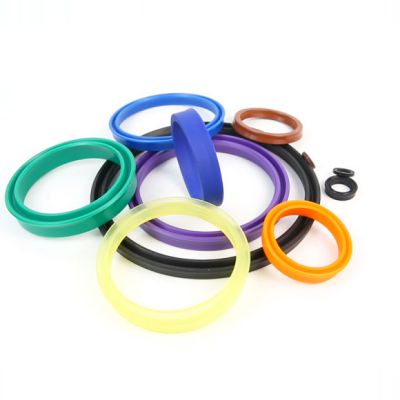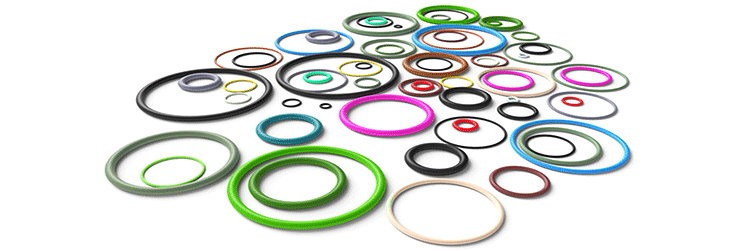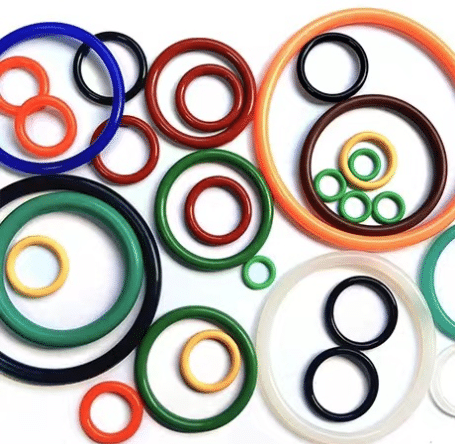单击 “编辑” 按钮更改此文本。这是测试文本。
Silicone seal rings are designed to create an enduring and reliable bond between two surfaces. Thanks to their resilient materials, flexibility, and resistivity to high temperatures and chemicals, these O-shaped or circular silicone accessories provide a perfect solution for applications in plumbing, automotive engineering, and mechanics.

The primary function of silicone seal rings is to prevent leakage of liquids or gases between two mating surfaces, such as pipes, valves, or mechanical components. They are typically placed in a groove or recess on one of the mating surfaces, and when the two surfaces are pressed together, the silicone ring compresses to form a tight, reliable seal.
Silicone seal rings are available in various sizes and shapes to accommodate different applications, and they can be custom-made to meet specific requirements.
Using silicone seal rings can be incredibly important in a variety of different applications. Here are some reasons why:
◊ Sealing Properties: Silicone seal rings offer excellent sealing properties, making them ideal for preventing leaks and keeping fluids from escaping.
◊ Temperature Resistance: Silicone is known for its high-temperature resistance, making it a great material for applications involving high heat or extreme cold.
◊ Chemical Resistance: Silicone is also highly resistant to many types of chemicals, including solvents, acids, and bases.
◊ Longevity: Silicone seal rings are known for their durability and long lifespan, making them a cost-effective solution over the long term.
◊ Versatility: Silicone seal rings can be used in a wide range of different applications, from industrial uses to home plumbing projects.
◊ Easy to Install: Silicone seal rings are typically easy to install and require no special tools or equipment.
Top 10 Mistakes to Avoid When Working with Silicone Seal Rings
Mistake #1: Choosing the Wrong Size
Selecting the right size silicone seal ring is critical to achieving an effective seal that will prevent leaks and other issues. Here is a step-by-step guide to selecting the right size:
Measure the pipe or fitting: The first step is to measure the diameter of the pipe or fitting where the silicone seal ring will be installed. Use a measuring tape to determine the exact circumference of the pipe or fitting.
Choose the right style: There are different styles of silicone seal rings available, including O-rings, square rings, and flange gaskets. Choose the style that is best suited for your application.
Determine appropriate seal cross-section: Look up the appropriate seal cross-section measurement in a chart or handbook that corresponds to your measured pipe circumference.
Check inner dimension: After determining the appropriate cross-section size for your seal, check the inner dimension of the ring to make sure it is compatible with the pipe or fitting.
Confirm temperature and chemical resistance: Confirm that the silicone seal rings you have chosen are compatible with the temperature range and chemical exposure present in your application.
Double-check before installation: Finally, before installing the silicone seal ring, double-check that it is the correct size for your application and that it will provide a reliable, leak-proof seal.
choosing the right size of the silicone seal ring is essential for ensuring a proper and effective seal, reducing the risk of leaks, contamination, and equipment damage, and improving overall performance and reliability.

Mistake #2: Incorrect Installation
Proper installation of silicone seal rings is crucial for achieving an effective and reliable seal. Here are some general guidelines for installing silicone seal rings:
Clean the mating surfaces: Before installing the seal ring, it is important to clean the mating surfaces thoroughly to remove any dirt, debris, or contaminants that may interfere with the seal. A clean, dry surface is essential for achieving a good seal.
Lubricate the seal ring: It is recommended to apply a thin layer of lubricant, such as silicone grease or oil, to the seal ring before installation. This helps the ring slide to place more easily and reduces the risk of damage or distortion during installation.
Place the seal ring in the groove or recess: Carefully place the seal ring in the groove or recess on one of the mating surfaces, making sure it is centered and properly aligned with the other surface.
Press the mating surfaces together: Once the seal ring is in place, press the mating surfaces together evenly and firmly. This compresses the seal ring and creates a tight, reliable seal.
Check for proper fit and alignment: After installation, check the seal ring to ensure it is properly seated in the groove or recess, and that the mating surfaces are aligned and even. If necessary, make any adjustments to achieve a proper fit.
Mistake #3: Not Cleaning the Surface
The silicone seal ring is a strong leakage part requiring strict conditions. Many people may hold the opinion that silicone seal ring doesn’t need to maintain regularly. Now I want to list some methods to clean our silicone seal ring.Proper cleaning of the mating surfaces is essential for achieving a good seal when installing silicone seal rings. Here are some methods for cleaning the surface:
Wiping with a clean cloth: The simplest method is to wipe the mating surfaces with a clean, dry cloth to remove any dust, debris, or loose particles. This method is best used for surfaces that are not heavily soiled or contaminated.
Solvent cleaning: For surfaces that are heavily soiled or contaminated with grease, oil, or other substances, solvent cleaning may be necessary. Use a suitable solvent such as isopropyl alcohol, acetone, or brake cleaner to clean the surfaces. Be sure to use appropriate personal protective equipment and follow all safety precautions and manufacturer’s instructions when using solvents.
Sandblasting or abrasive cleaning: For surfaces that have rust, corrosion, or another heavy build-up, abrasive cleaning may be necessary. This method involves using sandblasting equipment or abrasive pads to remove the build-up and expose a clean surface. Be sure to use appropriate safety equipment and follow all safety precautions and manufacturer’s instructions when using abrasive cleaning methods.
Ultrasonic cleaning: Ultrasonic cleaning is a method that uses high-frequency sound waves to create tiny bubbles that remove contaminants from the surface. This method is particularly effective for small or intricate parts that may be difficult to clean using other methods.
Mistake #4: Overstretching the Seal Ring
Overstretching a silicone seal ring can cause it to lose its shape and ability to create a seal. Here are some potential consequences of overstretched seal rings:
Leakage: The primary consequence of overstretched seal rings is the increased likelihood of leaks. The seal ring becomes less capable of maintaining a tight seal, leading to leaks.
Poor Performance: Overstretched seal rings can also cause the equipment to underperform or even malfunction in some cases. This can also lead to premature wear and damage to the equipment.
Equipment damage: Overstretched seal rings can cause damage to the equipment that they are intended to seal. This can be due to reduced performance, increased vibration, or other factors caused by the lack of proper sealing.
Safety Hazards: Overstretched seal rings can also lead to safety hazards in some cases, as fluid or gas can leak out of the system causing a variety of hazards.
Mistake #5: Using the Wrong Type of Sealant
Using the wrong type of sealant can cause serious issues with a silicone seal ring. Here are some potential consequences of using the wrong type of sealant:
Chemical Incompatibility: Different sealants are formulated to be compatible with different materials, so using the wrong type of sealant with a silicone seal ring can cause damage to the silicone, leading to decreased performance over time.
Poor Adhesion: Sealants intended for a different material can fail to properly adhere to silicone seal rings, resulting in a less effective seal and increased risk of leaks.
Degradation of Silicone: Certain sealants may cause the silicone to become brittle, reducing the seal ring’s flexibility and ability to create an adequate seal.
Reduced Lifespan: Using the wrong type of sealant can also shorten the lifespan of silicone seal rings. This can lead to the need to replace the seals more frequently, which can cause additional expenses over time.
Safety Hazards: In some cases, using the wrong type of sealant can create safety hazards due to leaks or other malfunctions.
Mistake #6: Not Replacing Old Seal Rings
Old seal rings should be replaced when necessary to maintain the proper functioning and safety of the equipment they are installed on. Seal rings are typically used to prevent fluid leakage between two mating surfaces, such as a shaft and housing in a pump or compressor. Over time, the seal rings may wear, become damaged, or be distorted, leading to fluid leaks or other issues.
Failing to replace old seal rings can result in increased fluid leakage, reduced efficiency, and potential safety hazards. For example, a seal failure in a pump or compressor can lead to significant equipment damage, environmental contamination, and even personal injury.
Mistake #7: Not Checking the Temperature Range
When using a silicone seal ring, it is important to always check the temperature range that the ring is able to handle. If the temperature exceeds the recommended range, the silicone seal ring can become damaged and may no longer properly seal. This could result in leaks or other issues that can compromise the integrity of the item being sealed. Always refer to the manufacturer’s instructions and follow any recommended temperature ranges to ensure optimal performance and longevity of the silicone seal ring.
Mistake #8: Using Damaged Seal Rings

Using damaged seal rings can be a significant issue in various situations, such as in industrial equipment, automobiles, and home appliances. In industrial equipment, seal rings are used to prevent the leakage of fluids, such as oil or gas, and to maintain the pressure required for the equipment to function correctly. Using damaged seal rings can result in leaks, which can lead to equipment failure, increased downtime, and potentially hazardous situations.
In automobiles, seal rings are used to prevent oil or coolant leaks, which can affect the performance of the vehicle and even cause engine damage. Using damaged seal rings can result in significant oil or coolant loss, leading to decreased fuel efficiency and expensive repairs.
In-home appliances and seal rings are used to prevent leaks of water or gas, which can be a safety hazard. Using damaged seal rings can cause leaks, leading to property damage, safety hazards, and costly repairs.
Mistake #9: Applying Too Much Pressure
If you apply too much pressure on a silicone seal ring, it may become deformed, which can result in a loss of its sealing properties. This can cause leaks or other problems in the device or equipment where the seal is used. It is important to follow the manufacturer’s recommendations for the proper amount of pressure to apply when installing or tightening the seal.
If you notice that the seal has been deformed due to excessive pressure, it is usually best to replace the seal with a new one. Continuing to use a damaged seal can lead to further problems or even failure of the equipment.
Mistake #10: Not Following the Manufacturer's Instructions
When using a silicone seal ring, it is important to follow the manufacturer’s instructions carefully to ensure the proper installation and functioning of the seal. Not following the instructions can lead to a variety of problems, including leaks, reduced sealing performance, and even damage to the equipment or device where the seal is being used.
Some potential issues that can arise from not following the manufacturer’s instructions include:
Over-tightening: If you apply too much pressure when tightening the seal, it can deform or damage the seal, resulting in a loss of its sealing properties.
Under-tightening: If the seal is not tightened enough, it may not provide an adequate seal, resulting in leaks or other problems.
Improper placement: If the seal is not placed in the correct position, it may not provide a proper seal or may become dislodged during use.
Incorrect use of lubricants: If you use the wrong type of lubricant, or apply too much or too little, it can affect the performance of the seal.
To avoid these issues, always refer to the manufacturer’s instructions when installing and using a silicone seal ring, and if you have any questions or concerns, contact the manufacturer for guidance.
Silicone Seal Ring Manufacturer with Over 16 Years of Experience
As a silicone parts manufacturer adept at custom silicone molding, we help you realize your components&products, spend a cost-effective price, ensure quality, follow on upon mass production, and support value-added services. We support service for silicone tubing, silicone seals, silicone o-rings, and other silicone parts.
